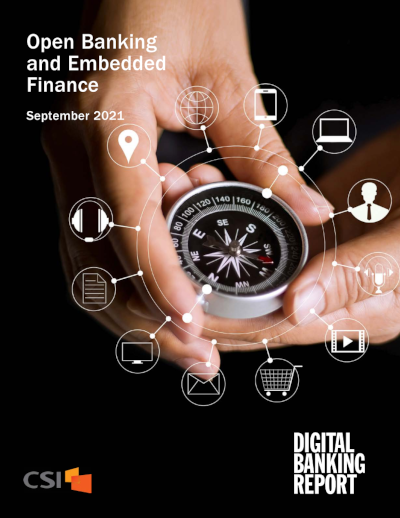Open Banking and Embedded Finance
Jim Marous
September 2021
: DBR 285
55 pages, 27 tables/charts
Download Printable Version of this page
Open banking is a global trend driven by technology, innovation, regulation, non-traditional competitive offerings, and consumer demand for enhanced financial services and control over how their data is used. Open banking allows for the secure transmission of account data authorized by the customer to a third party provider, leveraging APIs to power new financial solutions.
While the pace of open banking innovations has differed in different regions of the world due to varying paces of regulation, the potential of open banking has moved the financial industry toward data modernization and decentralization. This has provided the impetus for more open and cloud-based technology architectures, expanded data management needs, and the pursuit of new business partnerships.
The U.K. has provided a look into the potential for open banking and lessons to other banking organizations globally. In 2015, the European Union mandated open banking and APIs under its Payment Services Directive 2 (PSD2) and General Data Protection Regulation (GDPR) governing data protection and privacy for consumers. Other countries, such as India and Australia, have followed the E.U.’s approach.
In the U.S., regulators are providing guidelines for open banking, but allowing the marketplace to drive innovation. Guidelines have focused on consumer control and transparency, informed consent, safety, security, data privacy, and accountability for ecosystem risks.
Most banking organizations will have to support open banking and APIs in order to remain competitive. Successful organizations will customize the consumer or corporate client experience. For most banks and credit unions, the impetus will be less about revenue generation than it will be about sustaining customer loyalty and retention.
The mission for traditional financial institutions is to remain at the center of the customer’s permissioned data and financial relationships, making the relationship stickier. In the meantime, there is evidence that consumers are currently embracing their own version of open banking, opening new products and services with fintech providers on their own.
We’d like to thank CSI for their sponsorship of this Digital Banking Report on the future of open banking. The research shared in this report should provide an excellent foundation for discussion and planning for new business models in the future.
Open Banking and Embedded Finance
Advanced Analytics, AI, Analytics, Artificial Intelligence, Bank, Banking, Big Data, Credit Union, CRM, Customer Experience, Digital Banking, Digital Banking Transformation, Digital Lending, Digital Marketing, Digital Transformation, Engagement, Fintech, Innovation, Marketing, Mobile Banking, Open Banking, Payments, Personalization, Technology, Trends

